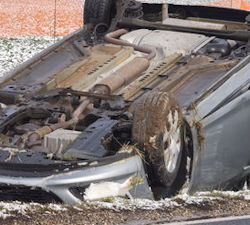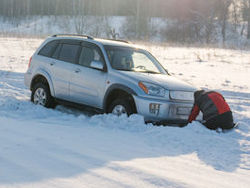Hazardous Road Conditions
Driving your vehicle in hazardous conditions, such as snow, heavy rain, or thick fog, is a matter of preparation, practice, and caution. And just because it is not a blizzard does not mean conditions are not hazardous.
- With the oils and exhaust that accumulate on highways, only a small amount of precipitation can cause the roadway to become slick, especially if it has not rained in a long time.
- A fog bank or dust storm can suddenly reduce your visibility to zero.
- Other hazardous conditions drivers may encounter, such as strong winds that down tree limbs or power lines, require extra caution from motorists.
Other types of hazardous road conditions include:
- Fixed objects on the road: Examples include utility poles, fallen trees, uncovered water drains, etc.
- Isolated spots of ice: These slick, frozen surfaces can make you spin or slide. Puddles of water can freeze to create this hazard.
- Dangerous intersections: Intersections on narrow roads or around sharp turns prevent you from seeing oncoming vehicles.
- Oil on the road: This can get slippery and dangerous.
- Poor guidelines: Over time, painted lines become worn and hard to see.
- Shoulder Drop-Off: If the space to the right of the road past the solid white line drops more than two inches from the road's surface, it can cause an accident:
- "Slippery When Wet" roads: These roads are proven to be slick and unsafe when they are wet.
- Flooded roads: It only takes 2 feet of water to float cars with a wide/low suspension. A vehicle will float when the weight of the water being displaced is equal to vehicle's weight. If in doubt, turn around.
- Wheel Ruts: Grooves where studded snow tires often go dig into the road and make it uneven and unsafe.
- Work Zones: There can be confusing directional signs and unpredictable changes in work zones. Go Slow!
- Potholes: Roads where asphalt has been removed, create holes that can damage tires, make cars swerve, and cause collisions.
Winter Driving Hazards
Driving safely in winter weather can be a challenge even for the most experienced drivers. It’s easy to forget after months of mild conditions that snow and ice demand careful driving and special preparation for your vehicle. Many vehicle crashes occur during winter conditions, especially while driving on black ice at night, on bridges, and shady areas. Many multiple-vehicle accidents occur as vehicles approach accident scenes (especially dangerous on highways), lack of visibility, and loss of control.
Dangerous situations you may encounter during winter driving include:
- putting traction devices on tires;
- removing snow from vehicle windows and rooftops;
- extreme weather conditions - extreme temperatures, white-outs, and heavy snowfall;
- sudden decreased control of the vehicle affecting steering and stopping;
- driving up to a sharp curve and you cannot see oncoming vehicles;
- driving in active hazardous work zones;
- you're stranded in a vehicle out in an isolated location;
- a vehicle is buried by snow and unseen by others;
- driving on snow-covered roads with unseen ice below;
- digging out when the vehicle is stuck in snow; and
- passing pedestrians walking on the side of the road.
Knowledge Check Choose the best answer for the question.
1-9. When is black ice is more likely to be present?
You forgot to answer the question!


